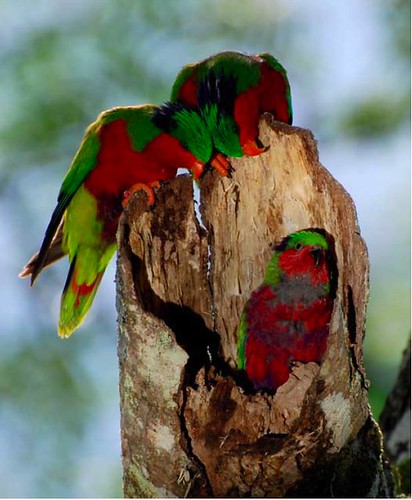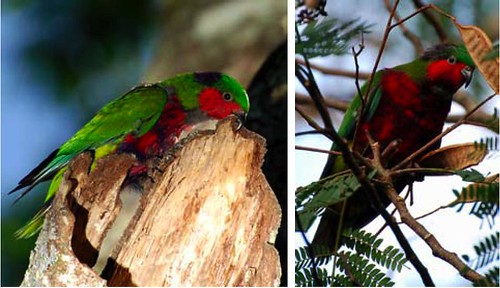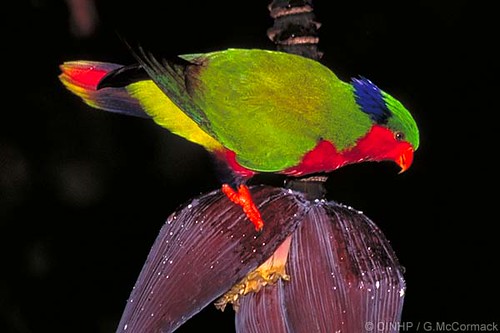tags: parrot, Lories, Lorikeet, Loriinae, Loriidae, Rimatara Lorikeet, Kuhl's Lory, Vini kuhlii, conservation, ornithology, South Pacific Islands
Endangered Rimatara Island (Kuhl's) lory, Vini kuhlii,
peer down upon their fledgling chick
in a nest hollow of an albizia tree, Falcataria moluccana,
on the island of Atiu, in the Cook Islands.
Image: Gerald McCormack [larger view].
Those of you who have been following the story of the endangered Kura, or Rimatara Lory, Vini kuhlii, will be very excited to know that these rare birds are producing babies! Last year, 27 Rimatara lories, or Kura, were translocated from the island of Rimatara to the rat-free island of Atiu, which is part of their historic range. The translocated birds were recently documented to be producing chicks in their new (historic) home.
Rimatara Lory fossils have been found throughout the southern regions of the Cook Islands, as well as on the small French Polynesian island of Rimatara. According to local stories, the small parrots' bright red plumage was highly prized, so the bird was hunted to extinction throughout its range, except on the island of Rimatara, where it was protected by tapu (taboo).
The former and current ranges of the Rimatara lory.
Image: Cook Islands Natural Heritage Trust (CINHT) [larger]
But in an effort to establish a second population of this highly endangered bird, 27 Kura were captured and translocated from Rimatara to Atiu in the Cook Islands in April 2007. Initially, the lorikeets remained in one large flock that ranged over most of the island. However, this large flock later split into two smaller groups of birds, each of which established a home territory in two smaller areas of the island.
Since most of the native birds on the island initiate breeding between September and December, it was assumed that these newly translocated lories would, also. So in preparation for a potential nesting attempt, a contest was announced in October 2007, with prizes for the island's residents who could document sightings of the first, second and third juvenile Kura to be born on Atiu.
The first juvenile was reported by members of the reintroduction program, Roger Malcolm and George Mateariki, on 21 February 2008. This young bird, or possibly other juveniles, was seen several times during March and April.
According to a report, a nest was found on 22 June and photographed by Danish photographer, Finn Neilson, on 20 July. The nest was located in a broken off branch that was roughly nine meters off the ground near the island's sawmill. Then on 10 August, two adult and two juvenile Kura were seen flying from the nest to a nearby tree and then back to the nest.
However, introduced common mynah birds, Acridotheres tristis, present a clear threat to the continued recovery of the much smaller Kura.
"In the case of one fledgling, two mynas twice made serious physical contact," noted the birds' photographer, Gerald McCormack. "One of these encounters lead to a prolonged contact conflict between the parents and the two mynas, which extended into a less intense conflict with more than 15 mynas. The fledgling survived -- partially aided by the presence of observers and the removal of several mynas."
Nevertheless, despite this challenge, there has been a recently confirmed report of a second Kura nest, although there have been no reports of either eggs or juveniles in that nest yet.
Endangered Rimatara Island (Kuhl's) lory, Vini kuhlii,
standing on a banana leaf. Also known as the 'Ura on Rimatara,
and the Kura on the island of Atiu.
Image: Gerald McCormack [larger view].
Interestingly, even though the Rimatara lories were only translocated to Atiu, at least four and possibly five birds flew 50 kilometers over open water from the island of Atiu to the neighboring rat-infested island of Miti'aro. The researchers decided to leave the lories there.
"These birds will be monitored to learn more about the effects of Ship Rat on the Rimatara Lorikeet," said McCormack, adding that the Kura is larger than both the Blue Lorikeet, Vini peruviana, and the Ultramarine Lorikeet, Vini ultramarina, whose numbers have been devastated by Ship Rat throughout French Polynesia.
Source
The Rimatara Lorikeet or Kura in Atiu (Cook Islands) First Annual Report By Gerald McCormack, Coordinator, Rimatara Lorikeet Reintroduction Project (2 September 2008) [PDF].





That bird does not look real - all those vivid colors. Too cool. Or rather hot.
Awww, cutie cutes!!! And LOVE the graph, lol!